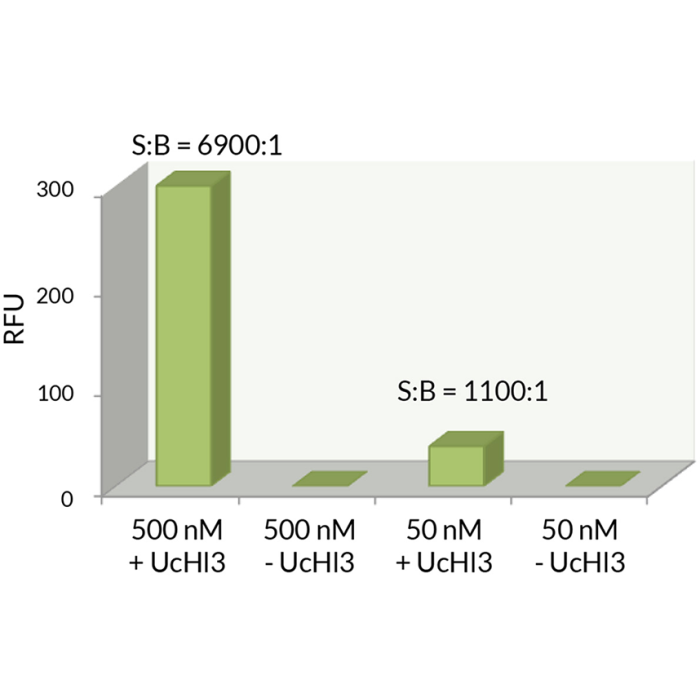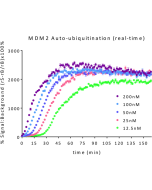Cookie Policy: This site uses cookies to improve your experience. You can find out more about our use of cookies in our Privacy Policy. By continuing to browse this site you agree to our use of cookies.
SouthBayBio
Ubiquitin (human) (rec.) (Rhodamine 110)

| Product Details | |
|---|---|
| Synonyms | UBB; Ubiquitin B |
| Product Type | Protein |
| Properties | |
| Source/Host | E. coli |
| Sequence | Human ubiquitin (aa1-76) (Accession Nr. P0CG47) conjugated at the C-terminus to a quenched Rhodamine 110 dye. |
| Crossreactivity | Human |
| Application | Protein-based substrate. Typical working concentration range is 50-500nM. Hydrolysis of the conjugate results in fluorescence observable by excitation at 485nm and emission at 535nm. |
| Label/Conjugates | Rhodamine |
| MW | ~9kDa |
| Purity | ≥99% (LCMS) |
| Concentration | Lot dependent. |
| Accession Number | P0CG47 |
| Formulation | Liquid. In 50mM MES pH 6.0. |
| Other Product Data |
Click here for a Typical Lot-specific Product Datasheet from the Original Manufacturer Our product description may differ slightly from the original manufacturers product datasheet. |
| Declaration | Manufactured by South Bay Bio. |
| Shipping and Handling | |
| Shipping | DRY ICE |
| Short Term Storage | -80°C |
| Long Term Storage | -80°C |
| Handling Advice |
Aliquot to avoid freeze/thaw cycles. Protect from light. |
| Use/Stability | Stable for at least 1 year after receipt when stored at -80°C. |
| Documents | |
| Product Specification Sheet | |
| Datasheet |
 Download PDF Download PDF |
Ubiquitin is a 76 amino acid post-translational modifier expressed throughout all tissues in eukaryotic organisms. The many roles of ubiquitin modification include proteasomal degradation, signal transduction, inflammatory response and DNA damage repair. Ubiquitin modification occurs through a pyramidal cascade of an E1 activating enzyme, E2 conjugating enzymes and an E3 ubiquitin ligase. This enzymatic cascade results in modification of a ε-amine of a lysine residue on a substrate protein. Substrates may either be mono- or poly-ubiquitinated by M1, K6, 11, 27, 29, 33, 48 or 63 linkages. Removal of ubiquitin from a substrate protein occurs via deconjugating enzymes, of which there are nearly 100 known enzymes with various specificities.







